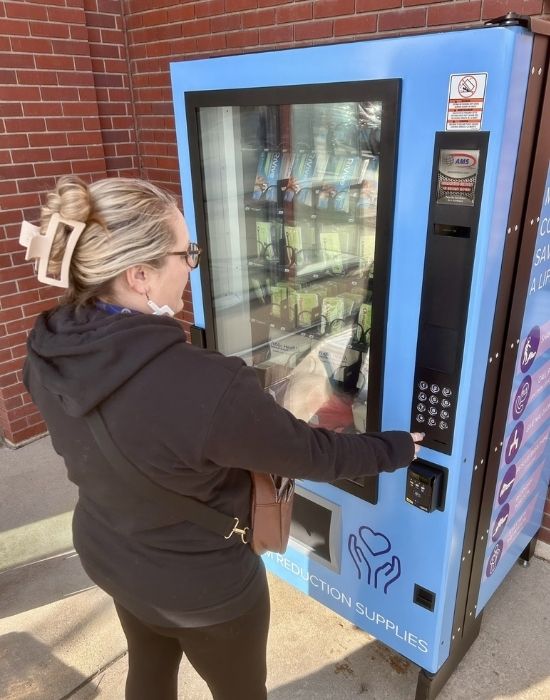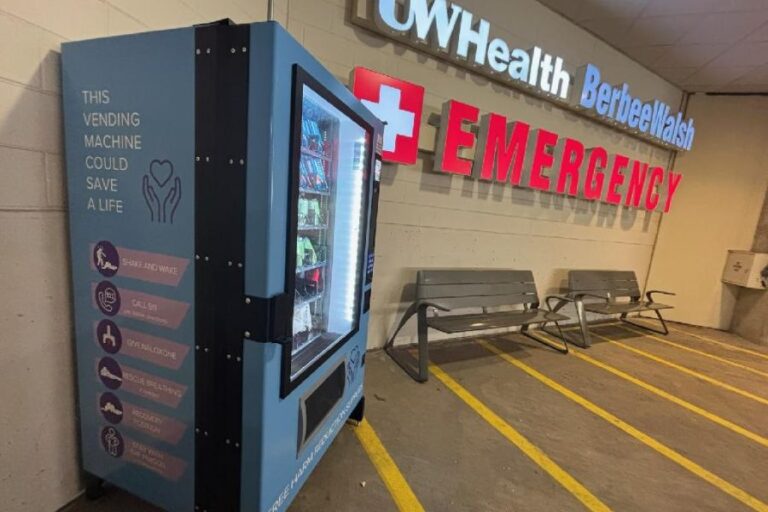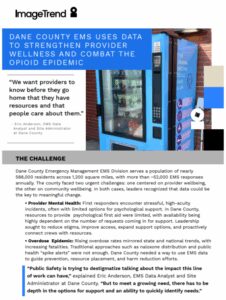The Challenge
Dane County Emergency Management EMS Division serves a population of nearly 588,000 residents across 1,200 square miles, with more than ~52,000 EMS responses annually. The county faced two urgent challenges: one centered on provider wellbeing, the other on community wellbeing. In both cases, leaders recognized that data could be the key to meaningful change.
- Provider Mental Health: First responders encounter stressful, high-acuity incidents, often with limited options for psychological support. In Dane County, resources to provide psychological first aid were limited, with availability being highly dependent on the number of requests coming in for support. Leadership sought to reduce stigma, improve access, expand support options, and proactively connect crews with resources.
- Overdose Epidemic: Rising overdose rates mirrored state and national trends, with increasing fatalities. Traditional approaches such as naloxone distribution and public health “spike alerts” were not enough. Dane County needed a way to use EMS data to guide prevention, resource placement, and harm reduction efforts.
“Public Safety is trying to destigmatize talking about the impact this line of work can have,” explained Eric Anderson, EMS Data Analyst and Site Administrator at Dane County. “But to meet a growing need, there has to be depth in the options for support and an ability to quickly identify needs.”
The Solution
Supporting Providers
To strengthen mental health support for EMS crews, Dane County introduced multiple layers of care:
- Peer Support Network: A trained group of providers now connects with crews after difficult calls, offering immediate support and resources.
- Continuum Alerts: Monitors were built for high-stress situations—pediatric cardiac arrests, mass casualty events, high-risk procedures—triggering real-time notifications to leadership.
- Rapid Outreach: Agency leaders and peer-support providers can now quickly contact crews to connect them with psychological first aid resources.
“Our process now is as soon as Continuum flags a stressful incident, we reach out,” said Eric Anderson. “We want providers to know before they go home that they have resources and that people care about them.”
Expanding Harm Reduction
On the community side, Dane County focused on new ways to address overdose risks:
- Heroin and Opiate Prevention & Education (HOPE) Kits: Every EMS agency now participates in distributing discreet kits that contain naloxone, fentanyl/xylazine test strips, CPR masks, and local resource guides. Crews can offer them directly to patients, families, or hospital staff, giving people options for immediate safety and long-term recovery.
- Harm Reduction Vending Machines: To address the gap that hospitals and EDs cannot stock harm reduction supplies inside, Dane County placed two vending machines with naloxone, test strips, HOPE kits, and other resources just outside high-volume hospitals. Locations were chosen using geocoded EMS data, transport destinations, and public transit access to maximize reach and utilization.
“We didn’t want to put machines in the middle of nowhere,” Anderson explained. “Using the data in our ImageTrend Elite system, we found 55% of transports for patients experiencing a suspected overdose already went to these two hospitals, and the third-highest volume facility was just a quarter mile away. We also rely heavily on scheduled reports in Report Writer, using criteria developed with Public Health epidemiologists to identify EMS responses for suspected overdose.”
Kailey Peterson, Opiate Prevention Specialist at Dane County, added, “The kits give more options than, ‘you’re either going to the emergency department or you’re not.’ Now patients, families, or even hospital staff have immediate harm reduction supplies and information.”
The Outcome
Dane County’s dual wellbeing through data initiatives have produced measurable results for both providers and the community:
Faster Support for Crews
Since launch, Continuum has triggered 689 email alerts and 668 text notifications, helping leaders rapidly flag stressful calls and connect crews with peer support—showing that even simple monitors can make a major difference.
Greater Buy-In
Providers report more openness to using peer support once they see that data is applied constructively, not punitively—underscoring the importance of explaining the “why” behind data collection.
Reduced Overdose Trends
From January 2024 through June 2025, EMS responses to suspected overdoses were 20% lower than the three-year average from 2021–2023. EMS crews are distributing more HOPE Kits, and vending machines are heavily used, with 2,000+ distributions at each site in the first six months.
Unexpected Community Impact
Feedback included stories like rideshare drivers using vending machine supplies to save lives; a reminder that once resources are accessible, the community will find ways to use them.
Stronger Collaboration
Scheduled reports and Continuum dashboards now keep EMS, hospitals, and public health aligned on overdose response and provider wellness, reducing duplication and strengthening trust across agencies.
As Eric Anderson summed up: “We’re more than just an ambulance. We are that bridge between public health and public safety. We care about our community, and we’re invested in its long-term wellbeing.”
What’s Next?
Dane County plans to strengthen its peer support program by expanding resources and encouraging providers to reach out proactively after difficult calls. The goal is to make mental health support as routine and accessible as any other tool crews rely on.
For harm reduction, the county is preparing to add vending machines in new areas and explore buprenorphine initiation programs with EMS partners. Continuum dashboards and geocoded data will continue guiding decisions, ensuring efforts reach the communities with the greatest need.
“If any county or department wants to start a leave-behind program (HOPE kits) or explore options for harm reduction vending machines, they’re welcome to reach out,” said Peterson. “This is my passion, and I’m here for it.”

Related Resources
Tomorrow Won’t Look Like Today. Prepare for What’s Next.
See the bigger picture and confidently face the challenges ahead with our industry-leading solutions.





